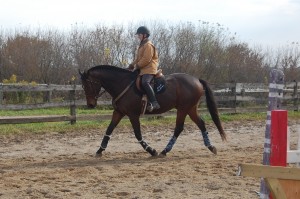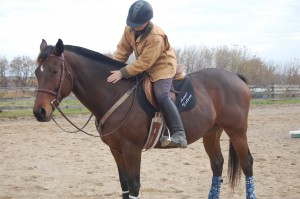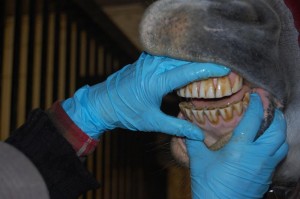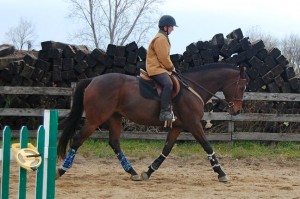Dr. Lori Dykeman, of private practice Paris Equine Services in Ontario, recently took time out of her busy schedule to offer insights and advice on achieving and maintaining overall good health in the horse.
In a Q&A interview with Off-TrackThoroughbreds.com, Dr. Dykeman offers on how to gauge whether a horse is at proper weight, and some guidelines for safely adjusting a horse’s diet. She also discusses the importance of good dental care, and ideas for achieving a holistic balance.
We hope this interview will provide our readers with a greater understanding of horse health issues and how to become better caregivers for our beloved pets.
Q: What are the keys to keeping a Thoroughbred at a healthy weight?
A: The starting point for a good diet is high quality forage – hay and pasture. Hay should be fed at 1.5 – 2% of the horse’s body weight as a starting point. Ideally a horse will have hay or grass in front of them all the time. Try to avoid long stretches of time when the horse has nothing to eat. Remember, horses are designed to eat very small amounts almost all day. Provide access to pasture as much as possible (assuming there is no medical condition which would preclude pasture access). If you are in a situation where you need to provide more calories than can be provided with forage alone, try something like molasses-free beet pulp first. Grains and complete rations can be added minimally, if required. When concentrates are required, feed after hay has been given and limit meals of concentrates less than four pounds per serving. I would like to discourage owners from feeding any feed or supplement that has high sugar, high starch contents. Avoid sugars.
Exercise and as much turn out as possible are important for your horse’s health. Many horses simply do not get enough exercise.
Consistency is important too. Be consistent with your routine, your feeding, and your exercise. Make changes very slowly.
Prevention of diseases and injury, as much as it is possible, is important to maintaining a healthy weight. If your horse is injured he can’t work and if he develops an infectious disease his caloric requirements increase. Attention to vaccinations, biosecurity, parasite control and dental care are all important.
Another piece of advice that is often heard is to weigh your horse’s food; don’t just eyeball it. If you are finding it a struggle to maintain a healthy weight because you think you are feeding lots of hay it might be worthwhile to have your hay analyzed and actually weigh the portions to ensure you are providing the calories and nutrients you think you are providing.
Q: What are some of the physical signs that a horse is in great condition, or needs additional weight or tone?
A: I believe the best tool we have to assess the condition of a horse is the body condition score (BCS). I use the Henneke body condition score, which uses a scale from 1 (emaciated) to 9 (very obese). It is easy to learn and easy to apply. With this scale, a score of 5/9 is ideal. One of the easiest criterions of the Henneke scale to assess is the ribcage. The ribs in a horse in ideal body condition cannot be identified individually visually but can be easily felt. If you can see ribs and count them the horse is too thin. If you cannot easily feel the ribs, the horse is overweight.
There are many versions of the Henneke body condition scoring system available on the Internet; most have drawings, photo examples of each score and written descriptions. Print one that works for you and keep it in your tack box.
Something I would like to emphasize, which might cause some disagreement, is that an ideal body condition is not unique to each breed. A BCS of 5/9 should look the same in a miniature horse as a Thoroughbred.
Q: Is weight fluctuation common in horses?
A: I think it is quite natural to see minor seasonal fluctuations, for example, when the winter round bales come out or the summer pasture comes in, but overall, given the opportunity, most horses will maintain a fairly constant body weight. I don’t worry about these small changes.
However, weight gain or loss that is sudden or very drastic needs investigating. The quality of the weight gain/loss is also significant. Are we seeing loss of muscle or muscle and fat? Are we seeing fat deposits appear in certain key areas, such as the crest of the neck? Is there a likely explanation for the weight gain/loss? For example, did you recently acquire new hay? Was your horse sick? Is there a change is he behavior too? Answers to these types of questions will help determine if a dietary, environmental or medical problem is at the root of the weight change.
Q: What are the first steps in the assessment and then treatment of a horse who is underweight? What do you look for and how do you put weight on without triggering other health issues?
A: My approach is to start with a detailed history, which can be quite convoluted and complicated in some cases. This may require a chat with the owner, groom, stable employees and anyone else who impacts the horse. A complete physical exam is required to assess each and every body system of the horse because weight loss can involve more than one system. I look at where the horse lives, how he lives, what he eats. I watch him eat. Laboratory tests are selected to help rule-in or rule-out systems. Advanced diagnostics may be required (such as scoping the stomach) depending on the findings.
The bottom line with weight loss is that the balance between calories in and calories out is not right. Ultimately we need to determine if the calories and quality of nutrients provided is sufficient. Sometimes the hay is such poor quality that the horse just cannot get adequate nutrition from the hay. At other times, the nutrition is adequate but the horse is not digesting or absorbing it properly. Or, the nutrition is absorbed but the horse is loosing nutrients due to an underlying disease process such as liver disease, colonic ulceration or kidney disease. Sometimes the horse is working at a level that demands more nutrition or is recovering from an infection or injury, which increases his metabolic demands.
The solutions and specific treatment for each case can be vastly different. The overall health of the horse needs to be taken into account. My approach to weight gain for a young, otherwise healthy horse, would be different that the approach taken for a geriatric horse with metabolic issues. Emaciated horses require extreme care and can suffer from a re-feeding syndrome if they are fed the wrong foods and in the wrong way. Slow and steady and conservative has served me well.
Avoid the temptation to feed underweight horses too aggressively and avoid sugars at all costs. When in doubt, take the time to work with a nutritionist and your veterinarian. There is always something to learn.
Q: Is there a standard food pyramid or calorie/weight chart that an owner can go by to help maintain good nutrition and weight for their horse?
A: Every horse is different. What you feed and how much depends on your horse’s age, health status, level of work, breeding status, availability of forages and seasonal variations.
A good place to start is with the Nutritional Research Counsel guidelines and then tweak the diet with input from equine nutritionists.
I like to build a diet around lots of hay and add components from there to ensure the diet is balanced and complete.
An excellent resource is the book [“Feed Your Horse Like a Horse”] by Juliet Getty. Also, there are many on-line correspondence courses available now to teach you the basics of nutrition and how to balance a basic diet. From there you can adjust the diet to meet the needs of performance horses, breeding horses, growing horses or horses with health issues.
Q: Please explain how a balanced mouth is achieved through dentistry, and how important the health of a horse’s mouth is in his or her overall wellbeing.
A: To eat properly and function at a level many of us expect from our horses, the lower jaw must be able to move side-to-side, up-and-down and also forward-and-back. A full range of motion that is pain-free is only possible if the mouth is “balanced” which means there are no malocclusions such as hooks, ramps, steps or waves. “Balancing” the mouth, to me, means preventing malocclusions from developing in the first place. When we can achieve this we can help every tooth to share in the work load of grinding forage, minimize the early attrition of teeth and help the horse to have a functional dentition for as long as possible.
The removal of the sharp enamel points (“floating”) is a very small part of dentistry. Thorough dentistry addresses the sharp points, addresses the malocclusions and helps to keep all of the tissues of the mouth (teeth, gums, tongue, cheeks, palate, etc.) healthy.
Today, horses definitely have the potential to outlive their teeth. Keeping the teeth in the horse’s mouth for as long as possible, and keeping them functional for as long as possible, has an obvious and direct impact on the horse’s wellbeing.
Problems in the mouth can be a source of pain, can cause performance problems, can affect digestion and can be a source of infection. Therefore, dental health has a profound impact on the overall health of the horse. Pain has so many negative consequences for the horse that my goal is do everything to eliminate or prevent it from ever happening. Colic and choke are two devastating examples of problems every horse owner would like to prevent. But, arguably, poor dental health can also have devastating ramifications: a horse can be discarded and branded as a “poor performer” because of the impact of a dental pain.
Unfortunately, I have seen some horses whose mouths are beyond re-balancing. At this point, the goal of treatment becomes elimination of pain, and improvement of their ability to eat. Most dental problems take years to develop; a hook or wave doesn’t just appear one day. I feel very sad whenever I look into a horse’s mouth and see an issue that could have been prevented years earlier, and worsened to the point it cannot be resolved.
Q: In your practice you describe the goal of achieving balance in five areas: the body, mind, mouth diet and feet. How do you help an owner achieve all this, and what is your approach? For example, do you choose the greatest areas of concern first? Or is there a whole-health approach?
A: First of all, the owner has to want to do this because it’s not easy. It’s not the conventional approach, its hard work and often there are some tough ups-and-downs to negotiate.
The answer to this question is “it depends.” It depends on the horse, the circumstances around the horse, the resources, the owner, the commitment and the expected outcome.
Sometimes the changes that need to happen to gain improvement are just too much for an owner to deal with, and I understand this completely.
The general approach is to identify every factor that is getting in the horse’s way. This requires a team to be in place – owner, vet, farrier, nutritionist, specialists, saddle fitters, massage therapists and trainers. Together, we prioritize the issues and determine a solution for each. Some things are quick and easy to fix. Some things cannot be fixed. The priority is always to eliminate pain and suffering and then work from there. For example, it may take 1-2 years to grow better feet. It may take a few months to deal with a behavioral problem.
The owner is the critical player. If we all work to get the diet fixed, the feet improved, the mouth balanced, but the owner insists on using a saddle that does not fit properly, and also uses draw-reins because the horse has back pain from the saddle, then we have not achieved anything for that horse. Every single person in that horse’s life must be on the same page or it will not work.
Q: How did you decide to pursue an equine veterinarian career, and how have your goals and treatments evolved since you began your practice?
A: I did not set out to become a vet. I wanted to ride and train horses and was working as a working student in a dressage barn when the acceptance letter came in the mail. I had an opportunity to continue my working student position at the same time. I was very conflicted, but my father gave me good advice. He said, “Get your education. You can always have horses as a hobby.” It was still a tough decision because I have always been more in love with the horses than veterinary medicine. However, veterinary medicine has given me the background and knowledge to help horses.
When I walked out of vet school I thought I knew a lot and had all the answers! It didn’t take 6 months before I realized I knew very little and wasn’t helping horses at all, at least not the way I wanted to help.
My first boss used acupuncture in his practice, and that was my first exposure to it. I would say that was the turning point for me. I left general practice after only 2 years to pursue studies in alternative medicine. I studied acupuncture and homeopathy. Out of necessity, due to one of my own horses, I studied podiatry and eventually dentistry. It’s funny that all of the subjects that interested me most were not part of my veterinary education.
I did contemplate for awhile that there was no place for me in veterinary medicine but being as stubborn as I am, I persisted and in 2008 opened my own practice to be able to practice the way I want to work and not because I have to work.
Q: Do you have any tips for owners who want to do the best for their horse, but also have budgetary constraints?
A: Someone very dear to me told me long ago, “Horses need care, not luxury.” That’s the best tip. Learn as much as you can. Keep it simple. Prevention truly is the best. A lot of what horses need to stay healthy does not cost a lot of money. Fresh air, consistent exercise, turn out, consistency in their routine. When you do have to spend money, spend it where it counts. Hoof care, vaccinations, parasite control, dentistry, and good quality hay. Let the horse be a horse. Companionship. Don’t waste money on supplements that may not be needed or may even be creating a nutritional imbalance. Be very selective about what you buy. Check your horse every day if you can. Walk your paddocks. When in doubt, seek help early before a small issue becomes a major expense.







You did a great job writing this it helped me out a lot with my thoroughbred she’s not an easy keeper but she has hay and grass every minute of the day but the beat pulp did a great improvement she now has great muscle and is so round I’m impressed with it
Susan, your blog is now a must-read for myself and I’m sure many, many others. What a great article, with lots of great advice! I love her approach to feeding and nutrition-our horses generally do not need loads of grain. Even if they do, forage and hay should always be increased first. It’s amazing to me how many people do the opposite. Well done!
Sarah,
That’s such a huge compliment. Thank you!!!
[…] the rest here: Veterinary Q&A: Healthy weight, good teeth ← How Else Can I Get More Weight Off Bertie? – Equine World UK […]
Wonderful article! Reminds me once again the importance of good basics for letting a horse live like a horse. Also the benefits that are reaped long term when we remember to listen to our heart while we peruse our dreams! Best wishes for you and your practice! May you make a bigger difference than you can imagine!
Martha, Dr. Dykeman was just amazing here. She is so busy running her practice, but yet, she took a considerable amount of time to think through insightful answers to my questions. I hope the tips and guidelines help others keep their horses at their best.
Amy, thank you for sharing this! 🙂
This is a great article! Very informative! I am going to share this! 🙂